How to Follow Blogs and Their Social Channels (Best Apps)
Source : How to Follow Blogs and Their Social Channels (Best Apps)
Published On : November 12, 2020 at 02:59PM
By : Ankit Singla
Reading a lot of blog posts lately?
Don’t succumb to information overload.
In this post, I’ll show you how to keep track of blogs you follow in the easiest ways possible.
It’s all about creating and managing content feeds.
Read on to find out more.
Table Of Contents
Why Manage Your Content Feeds?
As a blogger, you need to follow other experts and influencers to stay on top of your game.
I, myself, have a network of blogs that I follow for every single facet of blogging.
There’s Email Marketing Heroes for email marketing, Backlinko for SEO, and plenty more.
Whatever your niche, you need to constantly watch out for the latest trends that will give you a competitive advantage. And in the past, I used to get by just by bookmarking the blogs I follow.
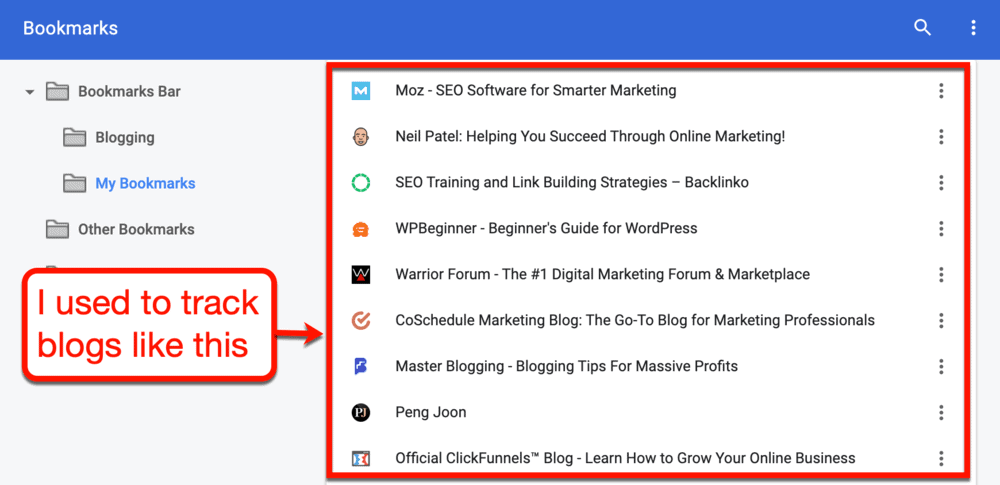
There’s just one problem:
The more blogs you follow, the harder it is to keep track of their content.
As a result, you may get left out on the hottest topics and trends making waves in your industry.
It was also a pain to look up facts and statistics I can use to come up with compelling points. In fact, I was better off using Google search than scanning my list of bookmarked blogs.
That’s when I discovered the art of consolidated web content feed management.

Sounds fancy?
It’s just a way of using automated blog trackers to get the web’s most valuable content in one place.
Here’s how to do it:
How to Find Blogs to Follow
First and foremost, you need to look for blogs that are worth following.
Below are some of the easy steps to do this:
1. Use Google search
You can use Google to quickly look for blogs to follow in your niche.
Simply attach a relevant keyword to the phrase “best blogs” and you’ll have heaps of sites to choose from.
For example, if you’re in the crochet niche, search for “best crochet blogs” and you’re pretty much done.

Here are a few other search queries you can use to look for blogs using Google:
- Top [niche] blogs in [current year]
- Popular [niche] bloggers
- [Niche] blogs in [location]
2. Use BuzzSumo
BuzzSumo is a straightforward content research tool that rounds up popular content using keywords and domains.
You can use it to look for top-tier blogs just by entering a keyword.
What’s great about BuzzSumo is that it lists down content based on user engagement, not just search engine rankings. That means you’re guaranteed to find bloggers who can produce highly valuable and informative content.
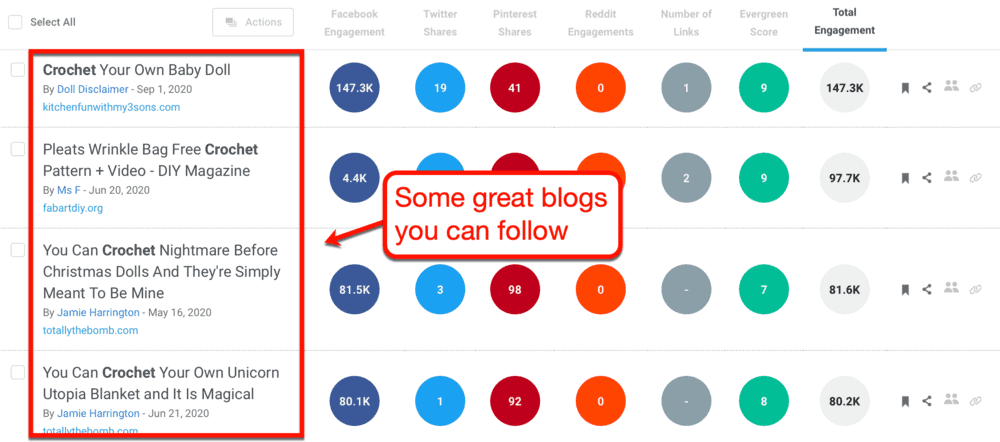
3. Investigate social media
In case you didn’t notice, you can also look for popular bloggers and brands on social media.
My personal recommendation would be Pinterest. Just be sure to select ‘People’ from the search menu to look for brands that create great content.
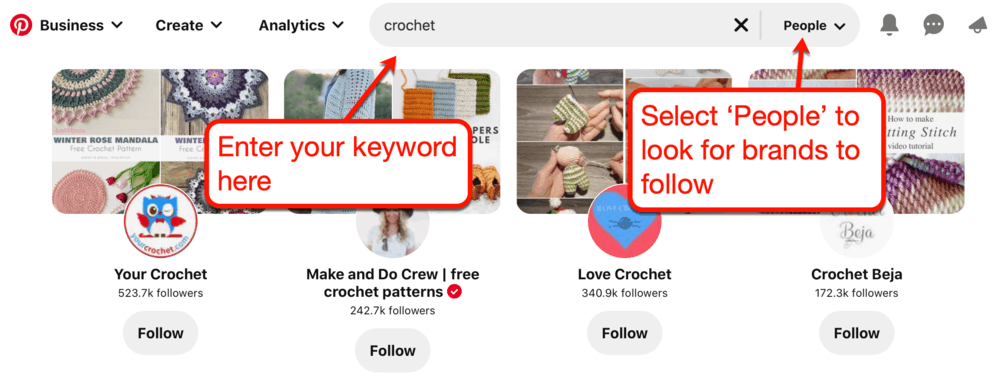
4. Look at the competition
If you want a really thorough search of blogs worth following, you can look at the top blog’s competitors.
A capable tool like SEMrush can help you with this.
Simply run a domain analysis and look at the “Main Organic Competitors” and “Competitive Positioning Map” sections of the report.

Got a long list of blogs you want to follow?
Good.
It’s now time to get to the good stuff.
How to Follow Blogs
Let’s face it, you probably don’t need a guide to teach you the basic ways to follow a blog.
You can follow them on social media, subscribe to their newsletter, and accept push notifications from blogs that offer them.
But if you want a consolidated content feed, you need to learn a little bit about RSS feeds.
What is an RSS feed?
RSS or “Really Simple Syndication” is a standardized web feed that allows users to obtain quick content updates from a website. They’re often alongside “news aggregator” apps that track RSS feeds from multiple websites and make them readily accessible to users.
Blogs, industry news sites, and publications like Computer World offer RSS feed URLs on their site that readers can follow.

Later in this post, we’ll take a look at tools you can use to follow blogs through RSS feeds.
But first, let’s address a key question:
What to do if a blog I like does not have RSS?
A lot of old websites feature an RSS feed icon to make it easier for readers to follow their blog.
However, even major websites today don’t outright promote their RSS feed URL.
But that doesn’t mean they don’t support it.
Here’s a known fact: all WordPress blogs have built-in support for RSS feeds.
If a website runs on WordPress, you can check its default RSS feed by adding “/feed” to its address.
TechCrunch, for example, doesn’t mention having an RSS feed on his homepage.

But by going to “www.techcrunch.com/feed,” we can verify that it’s actually there.

Unfortunately, not all websites use the default RSS feed URL format.
Some websites like Polygon use a different URL for their RSS feed. And if you tried checking the default URL, you’ll get a “404 Not Found” error.
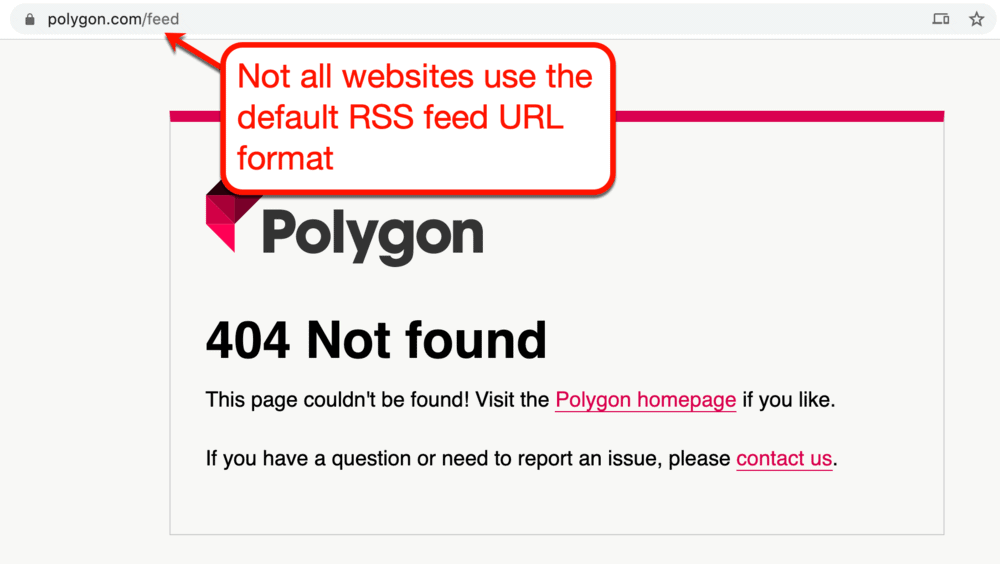
The good news is, you can easily find their RSS feed URL using a tool like FeedBurner.
How to check a website’s RSS feed via FeedBurner
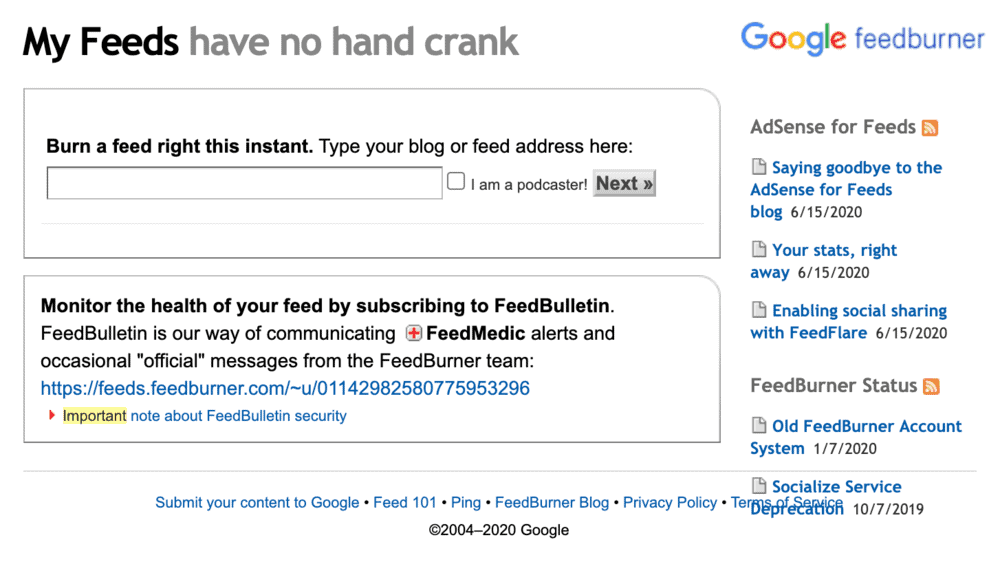
In simple terms, FeedBurner is a Google service that allows website owners to track their RSS feed subscribers.
Other than that, it also automatically scrapes the active RSS feeds of any given website.
For example, let’s enter Polygon’s URL into FeedBurner.
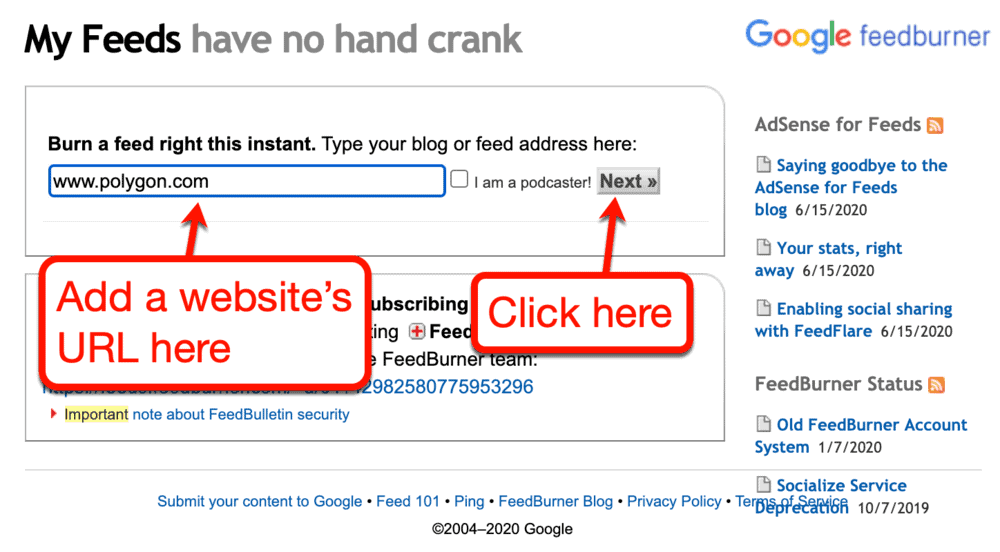
After clicking ‘Next,’ FeedBurner automatically presents us with all RSS feed URLs detected from that website.
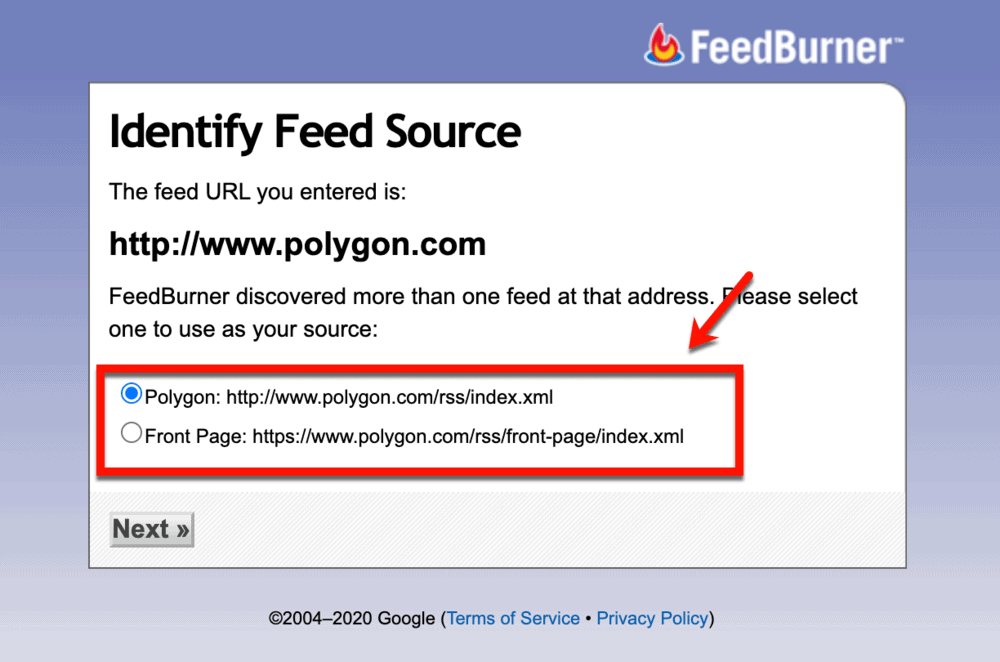
That’s it – you can now track that RSS feed URL on WatcherSpy.
I tried this method on dozens of websites that don’t mention their RSS feed. And so far, I always find a valid RSS feed URL that works with WatcherSpy.
Still can’t find a working RSS feed URL for your favorite website?
If a website really doesn’t support RSS, your best bet is to track their social media. There’s a good chance they pre-schedule their social media content promotions – perhaps with an automation tool IFTTT.
Best Tools to Follow Blogs With
Now that you know how to uncover the RSS feed URL of a website, let’s find a tool to plug it into.
1. WatcherSpy
Let’s get straight to the good stuff.
WatcherSpy currently offers the newest and best way to follow blogs.

In simple terms, it is a Chrome extension that lets you watch every blog you follow through a single feed.
Here’s how it works:
Step 1: Installing WatcherSpy on Google Chrome
To install WatcherSpy, you must first create a free account to receive an auto-generated password via email.

After getting your credentials, you need to install WatcherSpy from the Chrome Web Store.
Just click on the ‘Add to Chrome’ button to get started.

Upon installation, be sure to pin the extension to Chrome’s “Extension Bar.”
Just click on the ‘Extensions’ button and click ‘Pin extension’ next to WatcherSpy.

Lastly, you need to activate the extension by filling in your credentials.
This will finally unlock the main interface of the app, which should look like this:
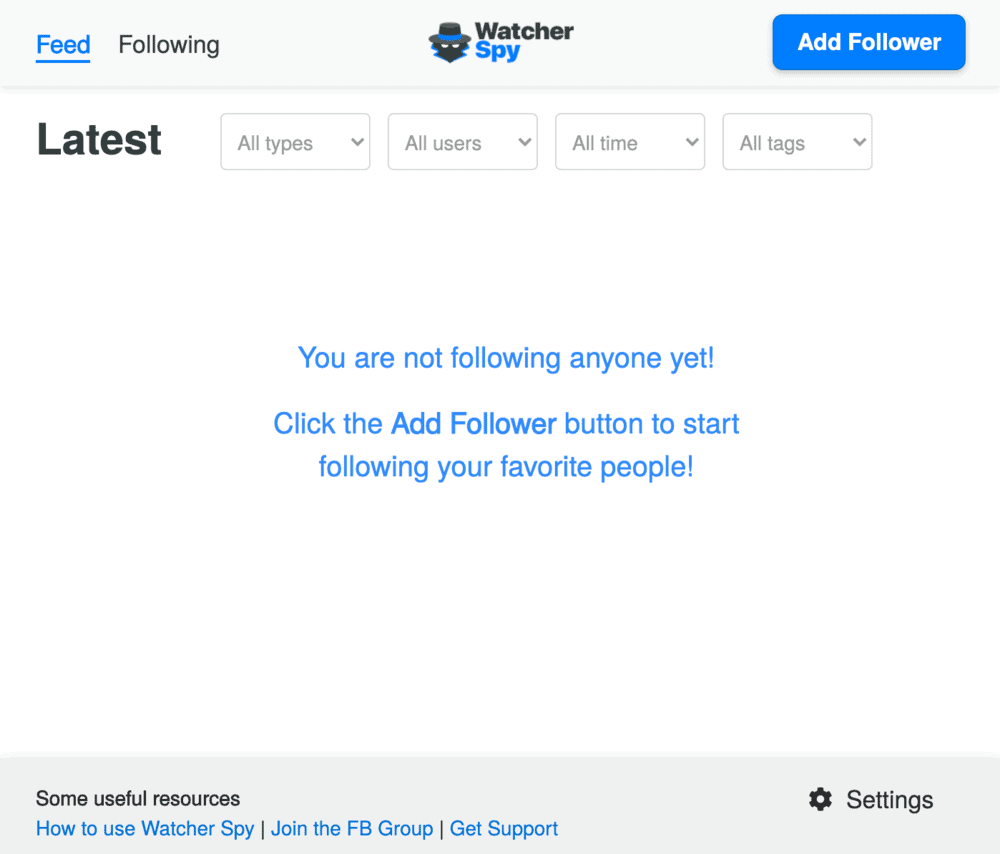
Step 2: Adding a follower
WatcherSpy allows you to create an automated “follower” that pulls in content from multiple sources.
For example, let’s say you want to track Brian Dean’s content from all over the web.
Start by clicking ‘Add Follower’ and then entering “Brian Dean” as the “Follower Name.”

Next up, copy and paste the right URLs into their corresponding fields.
You can copy the influencer’s YouTube channel URL, Pinterest page URL, Twitter username, and so on.
Most importantly, you can copy their blog’s RSS feed URL. This allows you to pull content straight from the influencer’s blog.
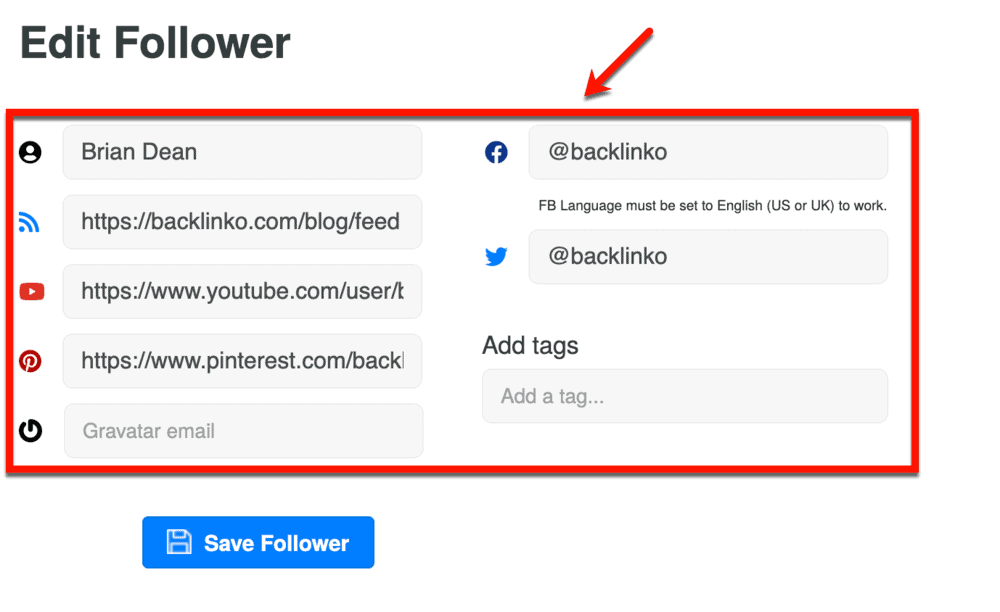
When done, click ‘Save Follower’ to finish this step.
Step 3: Tracking all information
With your automated follower up and running, your feed should now contain content pulled from all specified URLs.
All you have to do now is switch to the ‘Feed’ tab from WatcherSpy’s main interface.
Everything you need to see should be visible there.
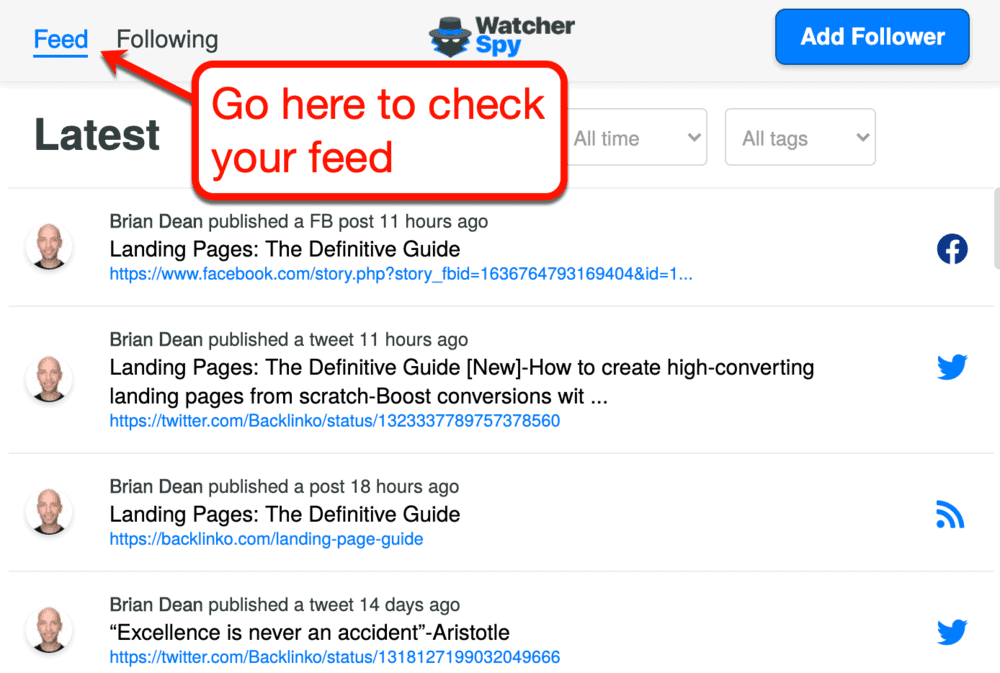
Easy, right?
Feel free to repeat the previous steps to start automatically tracking other authoritative influencers.
Step 4: Using tags and filters
If you think your feed is getting a bit overcrowded, remember that you can use WatcherSpy’s built-in filters.
You can filter content according to type, influencer name, date published, and tags.
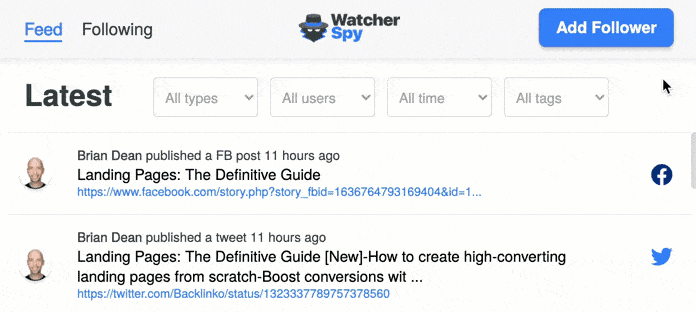
Speaking of tags, you can add them to followers at any time on the “Edit Follower” page.

I recommend using tags to group influencers according to their specific industry.
For example, I could use the “SEO” tag for Brian Dean and Moz. That way, I can simply filter my feed using this tag to search for SEO-related content.
2. Feedly
WatcherSpy is great for all-around blog tracking.
The drawback is, it only works if you’re browsing on your desktop or laptop computer.
Feedly is a good alternative if you want to manage and consume blog content on the go.

With Feedly’s mobile app for both iOS and Android devices, you can keep track of your content feed anywhere.
That means you’ll never miss out on the latest trends regardless of where you are and what you’re doing.
Let me show you how to use Feedly.
Step 1: Looking for sources to follow for content
What I really love about Feedly is the user experience factor.
After creating your new account, you can easily specify websites to track using the built-in search tool.
Take note that you can also use RSS feed URLs and topic keywords here.

Once the search is done, Feedly will show you a list of content sources that match your keyword. This is useful if you want a little diversification in your online information sources.
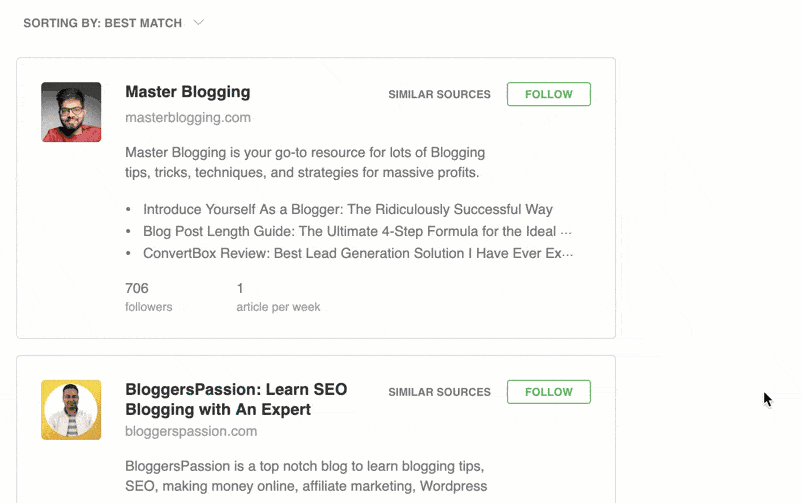
Click ‘Follow’ next to the source you want to monitor for content.
From there, you will be prompted to either select an existing feed or create a new one.
If you chose to create a new feed, all you have to do is give it a name and hit ‘Create.’
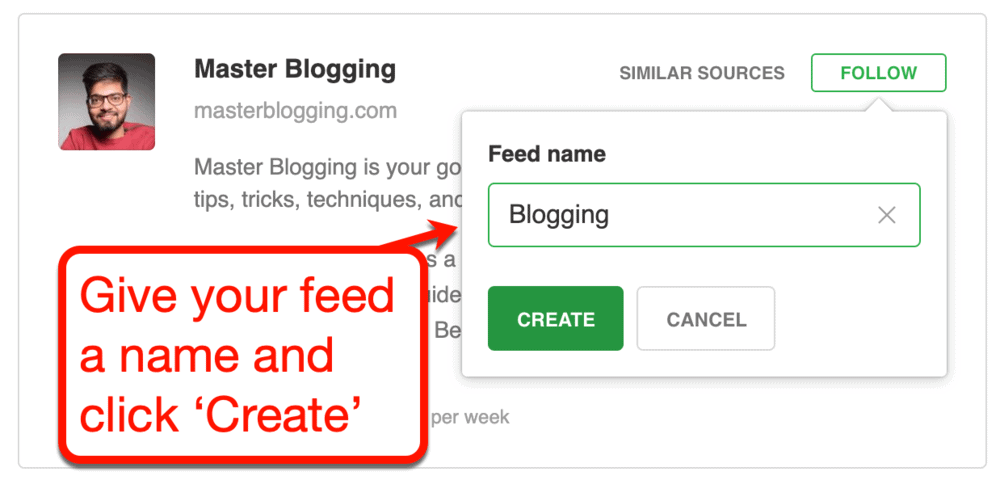
You should now see content from the specified source on the feed page.
To go there, look for the feed’s name under ‘Feeds’ from the main menu.
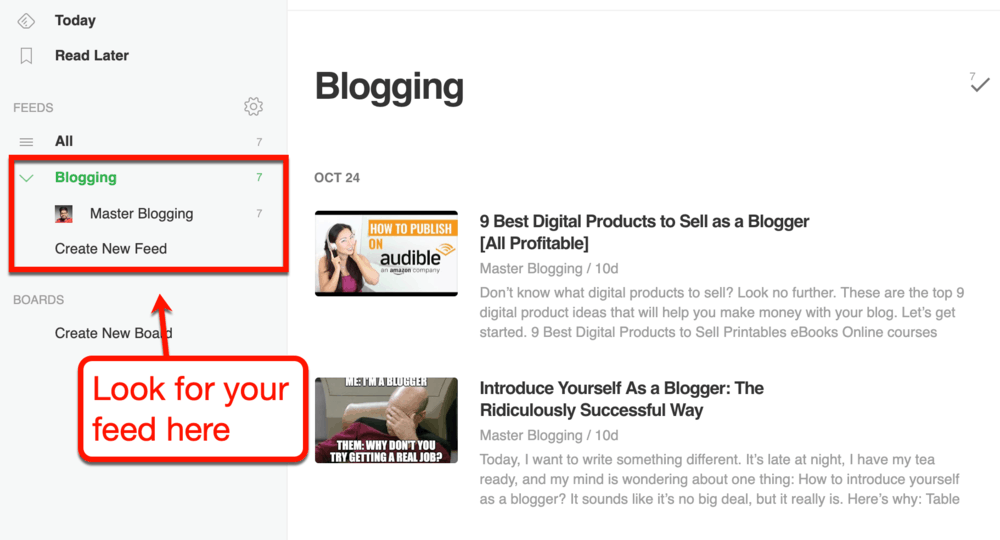
Step 2: Creating more feeds
If you’d rather create feeds first and add content later, click ‘Create New Feed’ on the main menu.
The only steps involved are picking a name for your feed and clicking ‘Save.’
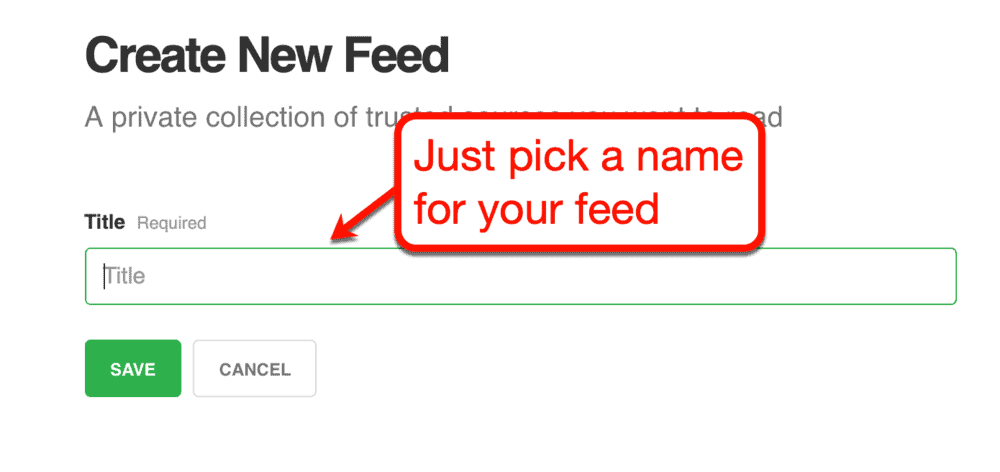
To start pulling content through your feed, click ‘Add Content.’
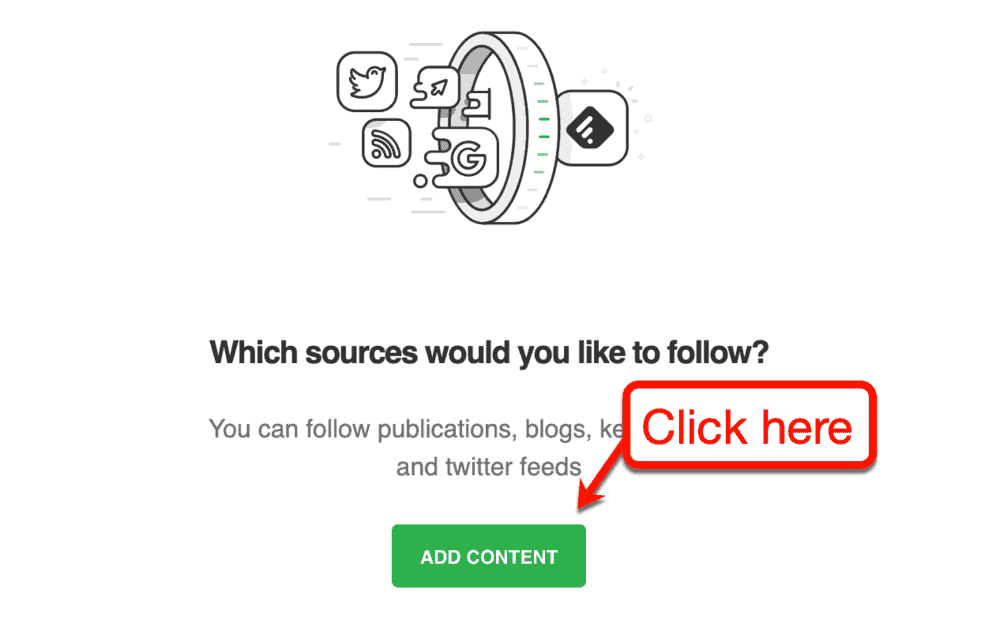
You will then be brought back to the “Follow New Sources” page, which we already covered in step one.
This leads us to the next step.
Step 3: Other ways to get more content
Apart from specifying a website, you can also look for sources using keywords from news sites and Twitter feeds.
For keyword alerts, you simply need to enter a keyword, company name, or product name while selecting a news site.

For Twitter feeds, you’ll have to use the Twitter handle of the account you want to follow.
Step 4: Get tracking
The main advantage of using Feedly is that all your feeds are synced across multiple devices.
If you have Feedly installed on your smartphone, you will be able to access your feeds from there.
You can also create and manage feeds without ever having to use Feedly’s web interface.
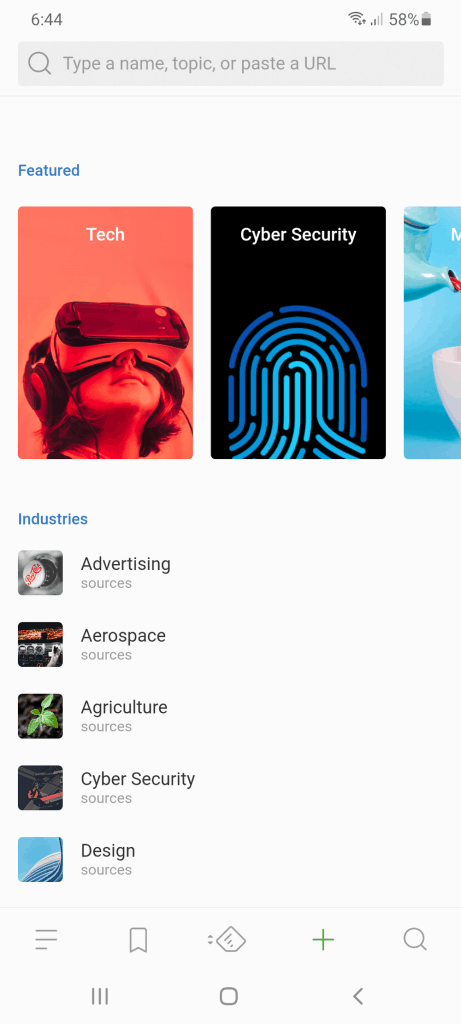
The downsides of using Feedly’s mobile app
Reading content on the go is the main appeal of Feedly’s mobile app.
Unfortunately, some users – particularly those with Android devices – are having concerns over the app’s usability.
For instance, a lot of users have issues with the gesture controls.
When reading an article, you may accidentally swipe from left to right while scrolling down. This prompts the app to take you back to the previous article.
That means you have to scroll all the way back to where you were in the article you’re reading.
You also shouldn’t scroll through your feed and tap to stop. If you do, Feedly will automatically open the page where your finger happens to stop.
It sounds like a minor issue. But it’s a major inconvenience for someone like me who likes to quickly scroll through heaps of articles.
Other than those concerns, the Feedly mobile app works well. In my opinion, it still offers the best way to read blogs on mobile devices.
3. Feeder
WatcherSpy and Feedly are my go-to apps for tracking RSS feeds.
But in case they didn’t suit your personal taste, let me show you some alternatives.
Feeder is a simple, browser-based RSS reader you can use to follow your favorite blogs. It features feed organization tools, filters, and a user-friendly interface that anyone can learn in no time.

4. Inoreader
Inoreader is another browser-based RSS reader that can compile the latest, relevant content from your trusted sources.
I personally find Inoreader’s interface better than Feeder, but that’s just a matter of preference. What makes it especially noteworthy is the set of advanced features like automation and keyword monitoring.

5. Flipboard
Lastly, Flipboard is a content-gathering app that can be used on your browser or mobile device.
I remember using their mobile app a few years ago – enjoying the “flipping” gesture control of browsing content.
Flipboard automatically aggregates content from countless reputable websites, allowing you to choose which sources to follow.
Of course, you can also follow blogs through their RSS feed URLs as well.

Conclusion
There you have it, folks.
That’s how to use content feeds to track blogs and stay ahead of the information curve.
It only takes a few minutes to set up a blog tracker and start regularly receiving content that matters. With an automated content feed, you’ll never get overwhelmed by having “too much information.”
If you have questions regarding content feeds, please leave a comment below. I also welcome any form of feedback as long as it’s coming from you guys.
See you in the next post!
You Might Also Like:
- Start a Profitable Online Business in Just 30 Days!
- How To Start a Profitable Blog on Instagram?
- 102 Blogging Tips: A Beginner’s Monster Guide to Profitable Blogging

For More Go to : Master Blogging
No comments